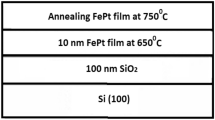Abstract
Ternary FeCrNi thin films were sputtered on polyimide substrates from the source (austenitic AISI 304 stainless steel) under the substrate rotation speeds of 0, 15, 30 and 45 rpm, respectively. The films with 50 nm thickness were sputtered at 0.9 nm/s. To the elemental measurements, while the Fe content slightly varied, Ni increased and Cr content decreased as the rotation speed increased. And, all films have a single crystal of (110) peak at the angle of 2θ ≈ 44.7° which is body-centred tetragonal (bct) martensitic α′-phase. Also, the peak intensity of (110) slightly varied as a result of changes of FeCrNi martensitic alloy contents in the films. Moreover, increasing substrate rotation speed resulted in a decrease in grain size. The morphologic analysis by a scanning electron microscope and an atomic force microscopy displayed a more homogenous structure and the decrease of film roughness parameters with increasing of rotation speed, respectively. For magnetic measurements, the saturation magnetisation, Ms increased from 995 to 1172 emu/cm3 and the coercivity, Hc decreased from 88 to 52 Oe with the increase of rotation speed. In the films, the increases of the martensitic structure formations and the decrease of the grain size were observed to have probably caused the increase of the MS values and the decrease of the HC values, respectively. As observed from the XRD results, ferromagnetic behaviour of the films may be due to the martensitic phase since austenitic phase has a weak paramagnetic behaviour as a source material at room temperature. From the parallel and perpendicular hysteresis loops, the films can also be obtained to have uniaxial in-plane anisotropy with increasing rotation speed. It is seen that the film properties can be easily varied by changing rotation speed for potentially new device applications such as spintronics, magnetic hetero-structures, magnetic separators, etc. on flexible substrates.






Similar content being viewed by others
References
J.R. Davis, ASM Specialty Handbook Nickel, Cobalt, and Their Alloys (ASM International, Metals Park, 2000), pp. 3–13
C.A.C. Sequeira, High Temperature Corrosion: Fundamentals and Engineering (Wiley, Hoboken, 2019), pp. 31–44
B.D. Cullity, C.D. Graham, Introduction to Magnetic Materials, 2nd edn. (Wiley, Hoboken, 2008), pp. 175–237
D. Jiles, Introduction to Magnetism and Magnetic Materials, 1st edn. (CRC Press, Arnes, 2015), pp. 69–80
M. Ohring, Materials Science of Thin Films, 2nd edn. (Elsevier, San Diego, 2002), pp. 103–105
B. Heinrich, J.A.C. Bland, Ultrathin Magnetic Structures IV: Applications of Nanomagnetism (Springer, Berlin, 2006), pp. 5–55
Y. Liao, Practical electron microscopy and database. (2018). http://www.globalsino.com/EM/. Accessed 29 May 2020
R. Pereira, P.C. Camargo, A.J.A. de Oliveira, E.C. Pereira, Surf. Coat. Technol. 311(1), 274–281 (2017)
Y. Xiao, Y. Liu, Z. Tang, L. Wu, Y. Zeng, Y. Xu, Y. He, J. R. Soc. Chem. 2016(6), 51096–51105 (2016)
Y. Cao, C. Zhou, J. Magn. Magn. Mater. 333(1), 1–7 (2013)
R. Ferrando, J. Jellinek, R.L. Johnston, Chem. Rev. 108(3), 845–904 (2006)
H. Kockar, J. Supercond. Inc. Novel Magn. 17(4), 531–536 (2004)
H. Köçkar, N. Kaplan, A. Karpuz, H. Kuru, B. Kaya, J. Supercond. Novel Magn. 38(8), 2457–2465 (2019)
S. Logothetidis, Nanoscience and Technology: Nanostructured Materials and Their Applications (Springer, Berlin, 2012), pp. 105–108
D. Shi, B. Aktas, L. Pust, F. Mikailov, Nanostructured Magnetic Materials and Their Applications (Springer, Berlin, 2002), pp. 129–144
J.P. Eymery, R. Krishnan, J. Magn. Magn. Mater. 104(1), 1785–1786 (1992)
J. Eymery, G. Laplanche, J. Magn. Magn. Mater. 93(1), 179–182 (1991)
N. Kaplan, H. Köçkar, A. Karpuz, H. Kuru, M. Uckun, J. Magn. Magn. Mater. 476(1), 597–603 (2019)
F. Delogu, Acta Mater. 59(2011), 2069–2074 (2011)
I. Meszaros, J. Prohaszka, J. Mater. Process. Technol. 161(1), 162–168 (2005)
B.D. Cullity, S.R. Stock, Elements of X-Ray Diffraction, 3rd edn. (Prentice-Hall, Upper Saddle River, 2001)
H. Kockar, T. Meydan, Physica B 321(1–4), 124–128 (2002)
Acknowledgements
Balikesir University Research financially supported this work under Grant No: BAP 2016/132. Also, Turkish State Planning Organization financially supported this study for Sputtering and VSM systems under Grant no 2005K120170. For the EDX and SEM measurements Advanced Technology Research and Application Centre, Selçuk University, Turkey, and for XRD measurements, Scientific and Technological Researches Application Centre, Karamanoglu Mehmetbey University, Turkey are greatly acknowledged. Dr. A. Karpuz1, Dr. O. Karaagac2, Dr. H. Kuru2, M. Uçkun2 (1Karamanoglu Mehmetbey University and 2Balikesir University, Turkey) are greatly thanked for their help.
Author information
Authors and Affiliations
Corresponding author
Additional information
Publisher's Note
Springer Nature remains neutral with regard to jurisdictional claims in published maps and institutional affiliations.
Rights and permissions
About this article
Cite this article
Köçkar, H., Kaplan, N. Single crystal martensitic phase of structural properties-related magnetic behaviour of FeCrNi thin films: in-plane magnetic anisotropy under different substrate rotation speeds. J Mater Sci: Mater Electron 31, 12823–12829 (2020). https://doi.org/10.1007/s10854-020-03835-4
Received:
Accepted:
Published:
Issue Date:
DOI: https://doi.org/10.1007/s10854-020-03835-4




